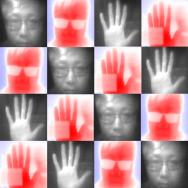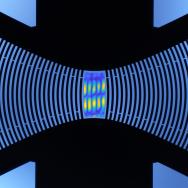A basic rule in our lives is that if energy can flow in one direction, then it can also flow in the reverse direction. For example, if you open a window and yell at someone outside, you also can hear if they yell back. But what if there was a way to create a “one-way street” for mechanical energy that only allows heat and sound to flow in one direction?
Finding new ways to break this basic symmetry has sparked the interest of scientists and engineers in recent years; such one-way streets could be extremely useful in applications ranging from quantum computing to cooling in electronics and devices.
A breakthrough experiment involving researchers with the Institute for Molecular Engineering at the University of Chicago and Yale University demonstrated that by using light to mediate the interaction between mechanical systems, they can create a controllable, one-way channel for the flow of vibrational energy and heat.
The study, published April 3 in Nature, was based on an idea developed earlier by the University of Chicago team and proves that the basic theory works. It also shows that the ideas can be implemented in a simple, compact system that could be incorporated in new devices.
“This is a really exciting resource that can be used in both classical and quantum contexts,” said study co-author Aashish Clerk, a professor in molecular engineering at the University of Chicago who developed the theory. “This research could open the door for many new studies.”
Breaking symmetry by using light
The principle that says energy and information exchange between two systems via a two-way street is known as “reciprocity,” and it is a fundamental rule in most physical systems. Breaking this symmetry is crucial in a number of different applications. For example, by preventing a backward flow of energy, one could protect a delicate signal source from corruption, or cool a system by preventing unwanted heating.
It’s especially important in quantum computation, in which scientists harness quantum phenomena to enable powerful new kinds of information processing. Breaking this symmetry ensures delicate quantum processors are not destroyed during the readout process.
In their experiment, researchers used a tiny vibrating membrane as the mechanical system. Much like a drumhead, this membrane could vibrate in several distinct ways, each with a distinct resonant frequency.
The researchers’ goal was to engineer a one-way flow of energy between two of these vibrational modes. To do this, the membrane was placed in a structure called an optical cavity, with two parallel mirrors designed to trap light. By shining light on the cavity using lasers, the researchers were able to use light as a medium for transferring mechanical energy between two vibrational modes. When the lasers were tuned carefully (in a way predicted by Clerk’s theory), this transfer mechanism was completely directional.
From theory to lab to the quantum level
The experiment was based on basic theoretical concepts developed by Clerk and his former postdoc Anja Metelmann (now at the Freie University in Berlin).
“You can come up with a lot of ideas that are exciting in terms of the basic theory and concepts, but often there is a gap between these abstract ideas and what you can actually build and realize in the lab,” Clerk said. “To me, it is exciting that our proposal was realized, and that the experimentalists had enough control over their system to make it work.”
The approach used in the experiment to achieve a one-way interaction—mechanical vibrations interacting with light—could pave the way for designing new devices targeting a variety of applications, ranging from mitigating heat flow to new kinds of communication systems. These unusual one-way interactions also have interesting fundamental implications.
As a theoretical physicist who focuses on quantum systems, Clerk is particularly interested in studying arrays where many quantum systems interact with one another in a unidirectional manner. This could be a powerful way to generate the unusual kinds of quantum states that are needed for quantum communication and quantum computation.
Other authors on the paper include Jack Harris, Haitan Xu and Luyao Jiang of Yale University.
Clerk is working with the Polsky Center for Entrepreneurship and Innovation at the University of Chicago to advance his discoveries.
Citation: “Nonreciprocal control and cooling of phonon modes in an optomechanical system,” H. Xu, Luyao Jiang, A. A. Clerk, J. G. E. Harris. Nature, April 3, 2019. Doi: 10.1038/s41586-019-1061-2
Funding: Air Force Office of Scientific Research, Simons Foundation
—Adapted from an article that first appeared on the Institute for Molecular Engineering website.

